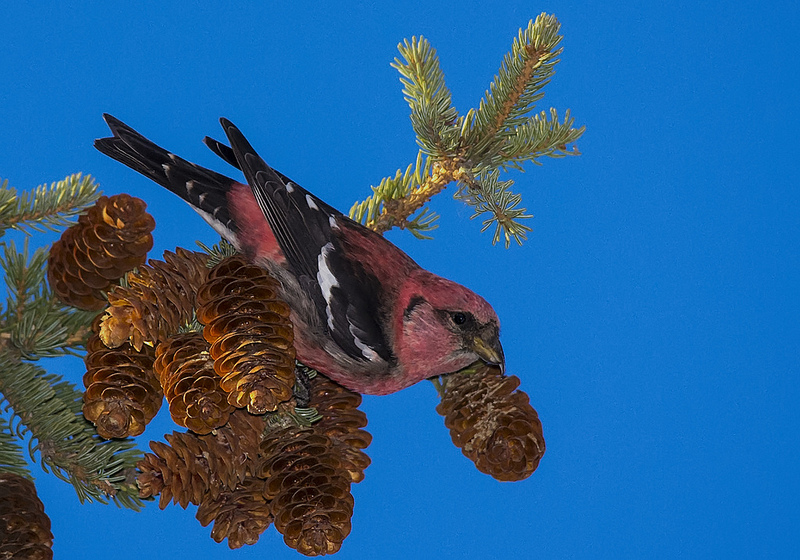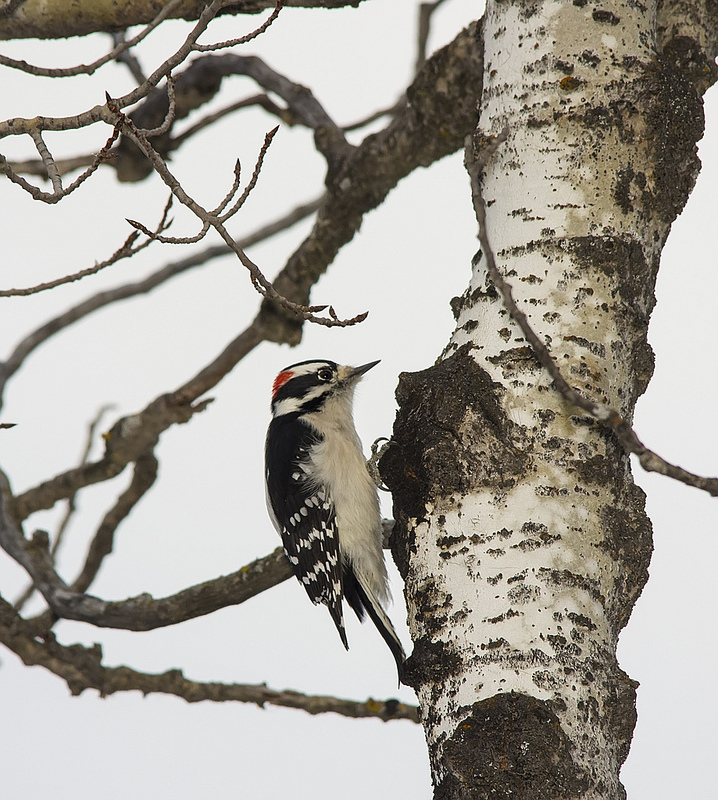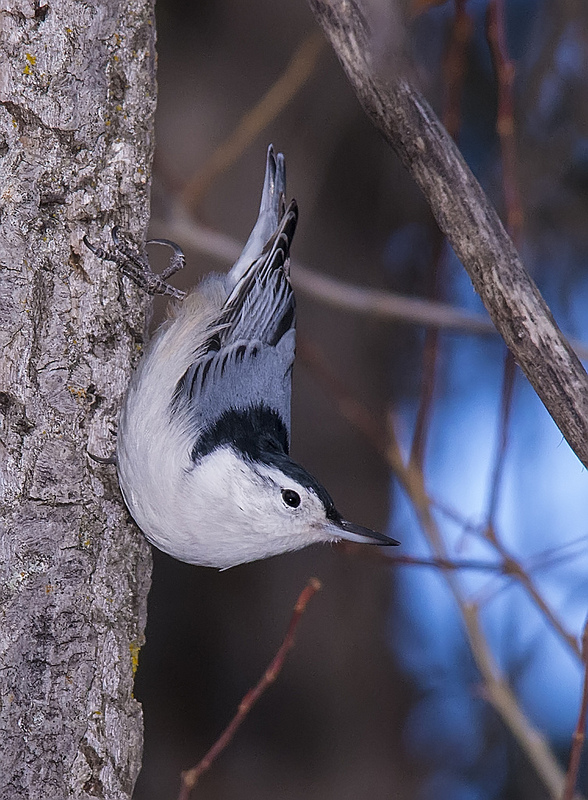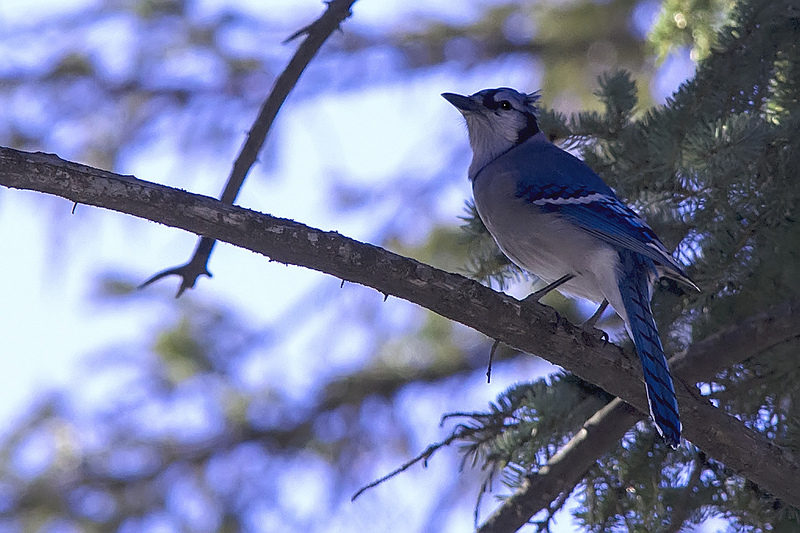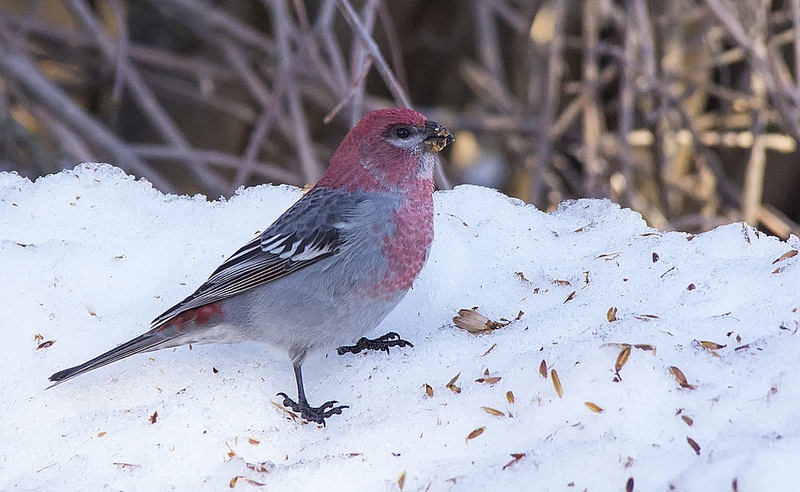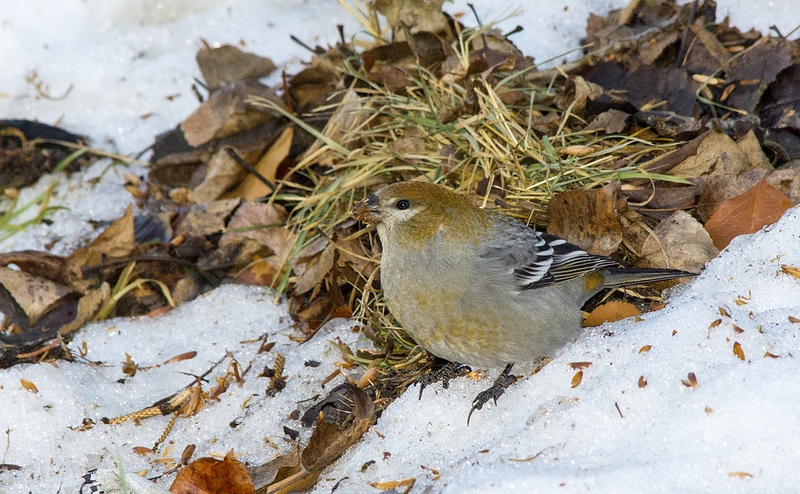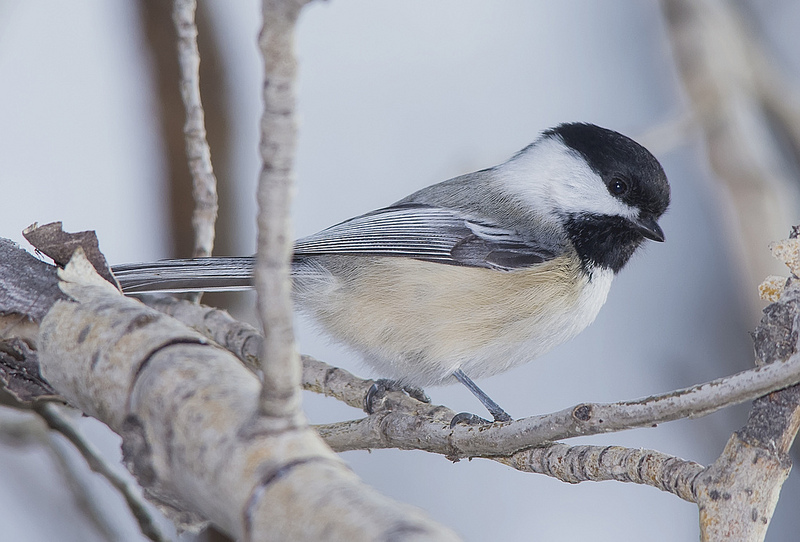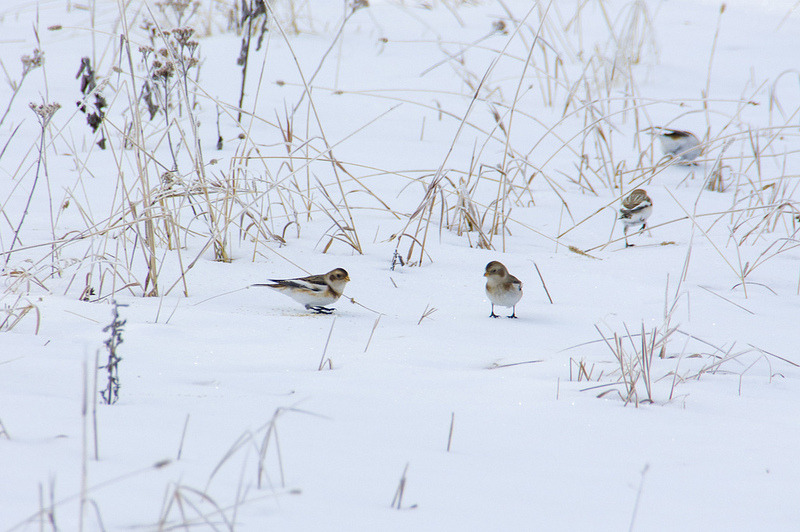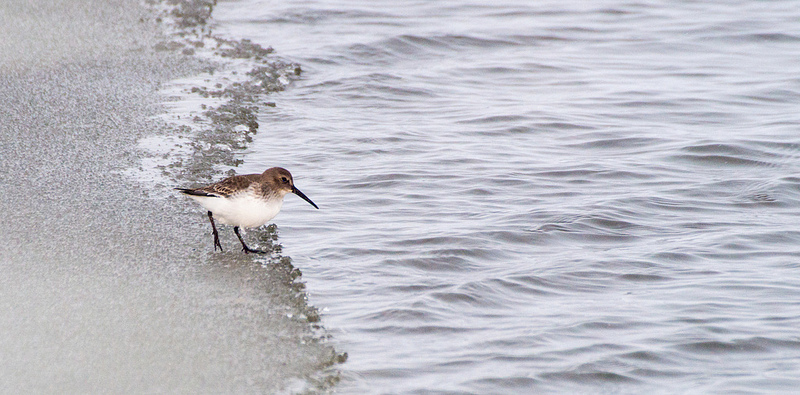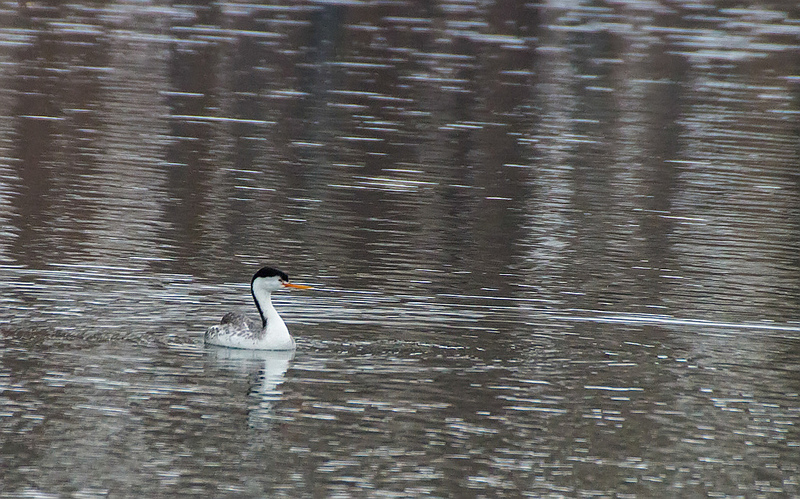These excellent photos of our winter birds were sent to us by Greg Earle. Thanks for sharing!
Friends of Fish Creek Autumn Birding – Bebo Grove and Shannon Terrace – Week Eleven
Posted by Dan Arndt
A gorgeous week of bird watching, above zero temperatures, and clear skies had me itching to get out to Bebo Grove this week. In past years, Northern Pygmy-Owls were fairly regular occurrences here, along with Grey Jays, and even the occasional Black-backed and American Three-toed Woodpeckers.
Sadly, this time around we didn’t get any of those unusual sightings, but we did get some really great close looks at some of the “winter finches”, some crazy squirrel antics, and while the species list was fairly short, the quality of the observations and the closeness of our interactions was without equal.
The day started with high winds, freezing rain, and cloudy skies, which did not diminish our spirits at all. In fact, it seemed that once we started walking into the wooded pathway, everything began to clear up. As we began, we were almost immediately made aware of a circling Red-tailed Hawk (Harlan’s subspecies), a pair of deer on the trail ahead of us, and one interesting little Red Squirrel raiding a cache of seeds and excavating the hole a little deeper still.
Nearby, we had our first close looks of the day at a few Red-breasted Nuthatches, who are always entertaining, and they even came in to eat out of the hands of some of our participants.
After we’d had our fill of feeding the Red-breasted Nuthatches and Black-capped Chickadees, we continued on until we were stopped in our tracks as we heard the overhead calls of White-winged Crossbills, who briefly touched down at the top of the spruce trees surrounding us. (These photos were taken a little later in the day, but it’s not often these birds are close enough to get good shots of, so I wanted to show them off!)

These tall spruce stands are typical of the habitat that makes up the majority of the Bebo Grove and Shannon Terrace areas of Fish Creek Provincial Park.
Onward to the west we headed, transitioning from the spruce stands to the currently barren poplar stands, where we were greeted by the drumming and foraging of this gorgeous little male Downy Woodpecker.
Another resident of the poplar stands was this White-breasted Nuthatch, who we heard long before we saw, and who gave us quite the show of grabbing seeds and wedging them deep into the crevices of the poplar bark with determined taps of the bill.
It was a while before we got good looks at many other birds. Sure we had fleeting glances at a few Blue Jays, Common Ravens, and even stopped to feed some extremely skittish Black-capped Chickadees, but the next really good looks we had at anything was this Blue Jay on the far west end. We heard it, along with two others, calling repeatedly from a spruce stand in an agitated manner. It never was clear why they were so agitated, but they were so cooperative and posing so well!
Almost as exciting was a small group of Pine Grosbeaks a little further along, just outside the Environmental Learning Center at Shannon Terrace, which might just be some of my best Pine Grosbeak photos I’ve taken so far.
And on we continued before stopping on our way back to feed the chickadees again. At least some of these little guys are grateful!
Thanks for reading, and have a great week!
Rare Bird Alert Calgary: Nov 15
Have you seen an unusual bird in Calgary?
If it is on this Reportable_Birds (PDF), please report it to the Nature Calgary Rare Bird Alert line at 403 221-4519 and leave a message after the beep at the end of the recording. If you would like some help with species identification, email us at birdscalgary@gmail.com. To report injured wildlife call the Calgary Wildlife Rehabilitation Society at 403 239-2488, or the Alberta Institute for Wildlife Conservation at 403 946-2361.
Compiled by Terry Korolyk
Nov. 12
–STELLAR’S JAY, seen around Bragg Creek for past two weeks, by Michael Woertman.
–SNOWY OWL(2),Twp.Rd.262 and RR255, by Eddie Matoud.
–NORTHERN PYGMY OWL,Powderface Tr.,Mt.McDougall Memorial parking lot, by Dan Arndt.
–SURF SCOTER(imm),Pinde Coulee Res., by Terry Korolyk
–RED-BREASTED MERGANSER(imm), same as above, by TK.
Nov.13
–TOWNSEND SOLITAIRE, Bebo Grove, FCPP, by Gus Yaki et al. Also seen there on the 14th.
Nov. 14
–MEW GULL, IBS, by DA. North end.
–NORTHERN PINTAIL/MALLARD hybrid, by TK, SW corner 22x and McLeod Tr.
–DOUBLE-CRESTED CORMORANT,Bow River, Beaverdam Flats,by Bill Wilson.
–GREATER SCAUP(f), same as above, by BW.
The next scheduled update of the Bird Alert is on Mon. Nov. 19th .
Rare Bird Alert Calgary: Nov 12
Have you seen an unusual bird in Calgary?
If it is on this Reportable_Birds (PDF), please report it to the Nature Calgary Rare Bird Alert line at 403 221-4519 and leave a message after the beep at the end of the recording. If you would like some help with species identification, email us at birdscalgary@gmail.com. To report injured wildlife call the Calgary Wildlife Rehabilitation Society at 403 239-2488, or the Alberta Institute for Wildlife Conservation at 403 946-2361.
Compiled by Terry Korolyk
Bird Sighting
Nov 6:
PACIFIC LOON, SURF SCOTER, female, south end of Tilley Res. east of Brooks, Robert Warple.
GYRFALCON, dark morph, west of Vauxhall, RW.
Nov 8:
SNOWY OWL, Cross Iron Blvd, east side of Hwy 2, Anthony Miller.
Nov 9:
HARRIS’ SPARROW, 4 miles s of Okotoks, Wendy Adam.
CASSIN’S FINCH male, Wintergreen Woods Est. Bragg Cr., canuckbirder.
Nov 10:
SHORT-EARRED OWL, GREAT GRAY OWL, nw of Cochrane between Grand Valley Rd/Twp Rd 280/Jack Eby Rd/ Hwy 579, Dan Arndt.
RED-BREASTED MERGANSER, WESTERN GREBE Beaverdam Flats, Gus Yaki/FFCPP.
TUNDRA SWANS (2), Bowness Pk, k25jh, and 2 at SW corner McLeod Tr/Hwy 22x, Terry
Korolyk.
Nov 11:
TUNDRA SWANS (2), Beaverdam Flats, GY etc.
The next scheduled update of the Bird Alert is on Thursday Nov 15.
Friends of Fish Creek Autumn Birding – Week Ten – Beaverdam Flats
Posted by Dan Arndt
One of the advantages (and disadvantages) of having my long lens unavailable for any length of time is the creativity that I’m allowed in the scenic and wide angle shots as opposed to the tight close-ups I’ve grown to prefer in the past year and a bit. I’ve also noticed that it seems like we always go to the same locations when I don’t have my long lens!
This week’s location, Beaverdam Flats, is just one such location.
Starting at the parking lot, we explored the trees nearby and found our only Golden-crowned Kinglet and Red-breasted Nuthatches of the day. Walking down the slope to the river we were greeted by a flyover of a juvenile Bald Eagle, and great views of both the river as a whole, as well as the frost that had accumulated overnight from the freezing fog.
The sheer number of Canada Geese and Mallards is hard to explain, and we even had a (relatively) small flock of Ring-billed Gulls on the gravel bar as well. Intermixed with the larger waterfowl were no small number of Buffleheads, Common Goldeneye, and even a Redhead or two for good measure.
We lucked out again and found a lone Barrow’s Goldeneye in amongst the throng, and were even a little more surprised by a lone, late migrating American Coot on the far bank.
As we followed the bend of the river around to the north side of the park, then trudged through back to the hilltop, we were greeted by our last new species in the park, this pair of Tundra/Trumpeter Swans. I suspect they’re Trumpeter Swans based on their proportions, but I could be wrong.
As we returned to our vehicles, we decided to go take a look in on Pat Bumstead’s amazing yard list, and specifically, to see the Mourning Doves. These two were found across the street roosting in a tall spruce.
Have a great week, and good birding!
Travel Tuesday – Rare and Random Calgary Birds!
Sunday Showcase: A Golden Eagle
Logan Gibson spotted this adult Golden Eagle on November 4 about 5 km west of Turner Valley. It had been feeding on carrion and flew to this tree to clean its talons before flying off.
Watch for more of Logan’s photography on the Alberta Birds Facebook group.
Calgary Christmas Bird Count 2012
The 61st Calgary Christmas Bird Count will be held on Sunday December 16, 2012. Phil Cram is organizing it, and as usual he’d like to get as many birders involved as possible. The goal is to have over 100 people in the field that day, and over 100 watching their feeders. If you want to participate in the field, contact Phil by email at crampj(at)gmail.com. If you’d like to take part in the Feederwatch program, email Jean Moore at jmmoore(at)ucalgary.ca or phone (403) 282-4162.
Note that Bird Studies Canada is no longer charging a $5 fee to participate in the field, as they did in the past.
Wood Duck. Photo by Daniel Arndt, December 11, 2011.
It would great to see new records for participation! It’s a lot of fun, so sign up now, and pass this message on to anyone you know who might be interested.
Rare Bird Alert Calgary: Nov 8
Have you seen an unusual bird in Calgary?
If it is on this Reportable_Birds (PDF), please report it to the Nature Calgary Rare Bird Alert line at 403 221-4519 and leave a message after the beep at the end of the recording. If you would like some help with species identification, email us at birdscalgary@gmail.com. To report injured wildlife call the Calgary Wildlife Rehabilitation Society at 403 239-2488, or the Alberta Institute for Wildlife Conservation at 403 946-2361.
Compiled by Terry Korolyk
Bird Sightings:
–ANNA’S HUMMINGBIRD(F), been seen for some weeks at a feeder at 4919-21Str.SW. by Lloyd and Barbara Trevors.
–RED-TAILED HAWK(HARLAN’S), at RR43 S.of the George Fox Trail N.of Cochrane, by Ron Kube. One was also seen on Nov.5th at Beaverdam Flats by Gus Yaki et al. Nov. 5
–LONG-TAILED DUCK(5) Glenmore Reservoir below the rowing club,by Sandra Savage.
–BLACK SCOTER(F or Imm) Glenmore Res., east bay, by Ray Wershler. Nov. 7
–RED-BREASTED MERGANSER(F), Bow River at Beaverdam Flats, by GY et al.
–THAYER’S GULL(1st yr.), Bow River about .5km N.of 22x bridge at a rocky point, by Terry Korolyk.










